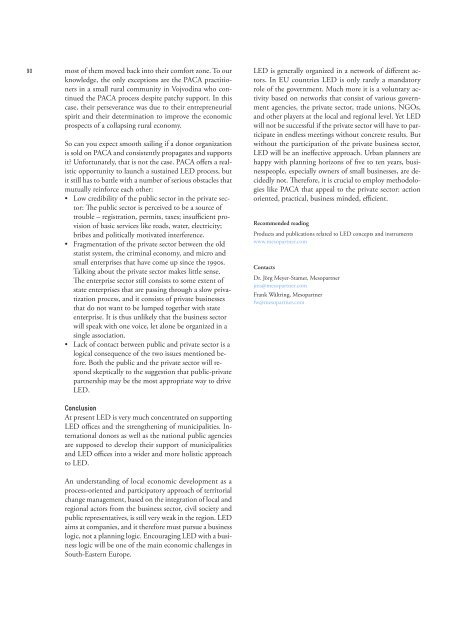Local/Regional Economic Development in South ... - Value Chains
Local/Regional Economic Development in South ... - Value Chains
Local/Regional Economic Development in South ... - Value Chains
Create successful ePaper yourself
Turn your PDF publications into a flip-book with our unique Google optimized e-Paper software.
90 most of them moved back <strong>in</strong>to their comfort zone. To our<br />
knowledge, the only exceptions are the PACA practitioners<br />
<strong>in</strong> a small rural community <strong>in</strong> Vojvod<strong>in</strong>a who cont<strong>in</strong>ued<br />
the PACA process despite patchy support. In this<br />
case, their perseverance was due to their entrepreneurial<br />
spirit and their determ<strong>in</strong>ation to improve the economic<br />
prospects of a collaps<strong>in</strong>g rural economy.<br />
So can you expect smooth sail<strong>in</strong>g if a donor organization<br />
is sold on PACA and consistently propagates and supports<br />
it? Unfortunately, that is not the case. PACA offers a realistic<br />
opportunity to launch a susta<strong>in</strong>ed LED process, but<br />
it still has to battle with a number of serious obstacles that<br />
mutually re<strong>in</strong>force each other:<br />
• Low credibility of the public sector <strong>in</strong> the private sector:<br />
The public sector is perceived to be a source of<br />
trouble – registration, permits, taxes; <strong>in</strong>sufficient provision<br />
of basic services like roads, water, electricity;<br />
bribes and politically motivated <strong>in</strong>terference.<br />
• Fragmentation of the private sector between the old<br />
statist system, the crim<strong>in</strong>al economy, and micro and<br />
small enterprises that have come up s<strong>in</strong>ce the 1990s.<br />
Talk<strong>in</strong>g about the private sector makes little sense.<br />
The enterprise sector still consists to some extent of<br />
state enterprises that are pass<strong>in</strong>g through a slow privatization<br />
process, and it consists of private bus<strong>in</strong>esses<br />
that do not want to be lumped together with state<br />
enterprise. It is thus unlikely that the bus<strong>in</strong>ess sector<br />
will speak with one voice, let alone be organized <strong>in</strong> a<br />
s<strong>in</strong>gle association.<br />
• Lack of contact between public and private sector is a<br />
logical consequence of the two issues mentioned before.<br />
Both the public and the private sector will respond<br />
skeptically to the suggestion that public-private<br />
partnership may be the most appropriate way to drive<br />
LED.<br />
Conclusion<br />
At present LED is very much concentrated on support<strong>in</strong>g<br />
LED offices and the strengthen<strong>in</strong>g of municipalities. International<br />
donors as well as the national public agencies<br />
are supposed to develop their support of municipalities<br />
and LED offices <strong>in</strong>to a wider and more holistic approach<br />
to LED.<br />
An understand<strong>in</strong>g of local economic development as a<br />
process-oriented and participatory approach of territorial<br />
change management, based on the <strong>in</strong>tegration of local and<br />
regional actors from the bus<strong>in</strong>ess sector, civil society and<br />
public representatives, is still very weak <strong>in</strong> the region. LED<br />
aims at companies, and it therefore must pursue a bus<strong>in</strong>ess<br />
logic, not a plann<strong>in</strong>g logic. Encourag<strong>in</strong>g LED with a bus<strong>in</strong>ess<br />
logic will be one of the ma<strong>in</strong> economic challenges <strong>in</strong><br />
<strong>South</strong>-Eastern Europe.<br />
LED is generally organized <strong>in</strong> a network of different actors.<br />
In EU countries LED is only rarely a mandatory<br />
role of the government. Much more it is a voluntary activity<br />
based on networks that consist of various government<br />
agencies, the private sector, trade unions, NGOs,<br />
and other players at the local and regional level. Yet LED<br />
will not be successful if the private sector will have to participate<br />
<strong>in</strong> endless meet<strong>in</strong>gs without concrete results. But<br />
without the participation of the private bus<strong>in</strong>ess sector,<br />
LED will be an <strong>in</strong>effective approach. Urban planners are<br />
happy with plann<strong>in</strong>g horizons of five to ten years, bus<strong>in</strong>esspeople,<br />
especially owners of small bus<strong>in</strong>esses, are decidedly<br />
not. Therefore, it is crucial to employ methodologies<br />
like PACA that appeal to the private sector: action<br />
oriented, practical, bus<strong>in</strong>ess m<strong>in</strong>ded, efficient.<br />
Recommended read<strong>in</strong>g<br />
Products and publications related to LED concepts and <strong>in</strong>struments<br />
www.mesopartner.com<br />
Contacts<br />
Dr. Jörg Meyer-Stamer, Mesopartner<br />
jms@mesopartner.com<br />
Frank Wältr<strong>in</strong>g, Mesopartner<br />
fw@mesopartner.com



